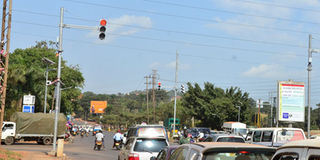Motorists up in arms over new Lugogo traffic lights

On the road. Motorists at the Lugogo Bypass wait after being stopped by the newly installed traffic lights. PHOTO BY MICHAEL KAKUMIRIZI
What you need to know:
- Plan. Lugogo traffic lights are among the four newly installed junctions, bringing the total number of the signaled junctions in the city to 23. KCCA plans to have at least 42 junctions signalised by end of this year.
- Old. Some junctions that have since been signalised by KCCA include; Makerere Hill, Kira Road, Fairway, Bwaise-Mambule Road junction and Kabira Junction among others.
- New. The newly signalised junctions are; Lugogo Junction, Kololo near Kati-kati, Lugogo Bypass-Naguru Road and the Upper Kololo Terrace-Wampewo Junction.
- Cost. This process and construction of city roads project is under the Second Kampala Institutional Infrastructure Development Project (KIIDP-2) which is funded by World Bank. The whole project will cost $183m (Shs700b).
Kampala. When Kampala Capital City Authority (KCCA) installed traffic lights at the Lugogo junction in between Lugogo Shopping Mall and Lugogo Indoor Stadium to ostensibly ease traffic jam, motorists received the news with enthusiasm, little did they know that the traffic signals could cause more harm than good. Motorists who ply the junction speak with disgust how the Lugogo traffic lights have contributed to the increasing traffic jam.
Mr Hassan Kyazze, 34, a boda boda riders says he has plied Kampala routes for 17 years.
He says: “Before these traffic lights were installed, one could move from the Jinja Road traffic lights with much ease and stop at Nakawa traffic lights. However, with these new lights at Lugogo, one has to stop thrice, hence causing traffic jam at Lugogo.”
Mr Kyazze advises that the traffic lights at Lugogo should have been installed at Spear Motors after Nakawa because it is a traffic jam-prone area.
“The problem with these Lugogo traffic lights is that some of the motorists, especially those coming from Kololo to Nakawa, have to stop yet this should not have been the case. Also, those motorists from Nakawa heading to town are supposed to stop at the Jinja Round Traffic lights and not Lugogo because there is no heavy traffic there. KCCA must revisit this,” he says.
Mr Kyazze’s concern is shared by other motorists who have questioned KCCA’s move to install traffic lights at Lugogo.
However, according to KCCA’s plan, the Lugogo traffic lights are meant to ease traffic flow on Jinja Road.
As such, cars from Jinja Road are supposed to stop at Lugogo to allow those at the Nakawa traffic lights proceed so that when those from Lugogo reach Nakawa, traffic is cleared.
But Ms Sandrah Nalubega, a banker who normally uses the Lugogo Bypass to her work place in Kamwokya, says the idea needs to be revisited because some cars are stopped yet they are actually not supposed to stop.
“You see, before these lights were installed here, all cars from Jinja Road would stop at the Nakawa traffic lights, hence Lugogo would be free with no jam because majority of the cars were either at Jinja Road or Nakawa traffic lights. Lugogo had never had traffic jam but when you reach this place during peak hours, it is a total mess,” she says.
KCCA acknowledges the fact that the new traffic lights would not mean business as usual and thus some motorists would be affected. They advise the affected motorists to use alternative routes.
Traffic police speaks out
On the other hand, the spokesperson of Traffic police, Mr Charles Ssembabulidde, acknowledges complaints from motorists but says some of them are not compliant with the traffic rules.
“Let us look at how these traffic lights work because they are still new and we are still monitoring them. It’s no doubt that these newly signalised junctions are slowly reducing traffic jam but the only problem is that some motorists don’t comply with traffic rules,” he says.
He notes that police have since launched a crackdown on motorists who defy traffic laws and later causes traffic jam such as driving on walkways, pavements and creating unnecessary lanes on the road.
From the crackdown, Mr Ssembabulidde says at least 500 motorcycles have been impounded and more than 100 cyclists arrested.
KCCA’s directorate of engineering were the roads and transport department is based referred us to Mr Peter Kaujju, the director of corporate affairs, who said the authority would issue a press statement today.
But Dr Amin Tamale Kiggundu, a senior Lecturer of Urban Planning at Makerere University advises that to reduce traffic jam on Kampala roads, government must start investing in public transport means to weed out taxis by replacing them with cars such as minibuses (coatas) and buses that carry more passengers.
“Also, KCCA must also ensure that access roads are catered for because they can be used as alternative means by motorists to easy traffic flow,” he says.
In September 2015, JICA signed a loan agreement with the government of Uganda for $200m for the Kampala Flyover construction and road upgrading project.
The project is aimed at contributing to the reduction of traffic congestion in Kampala. It involves construction of flyovers at Kitgum House and Clock Tower junctions, widening of Mukwano Road, construction of an underpass junction at Nsambya junction, improving of other associated junctions within the project area as well as traffic safety improvement at Shoprite and clock Tower.




